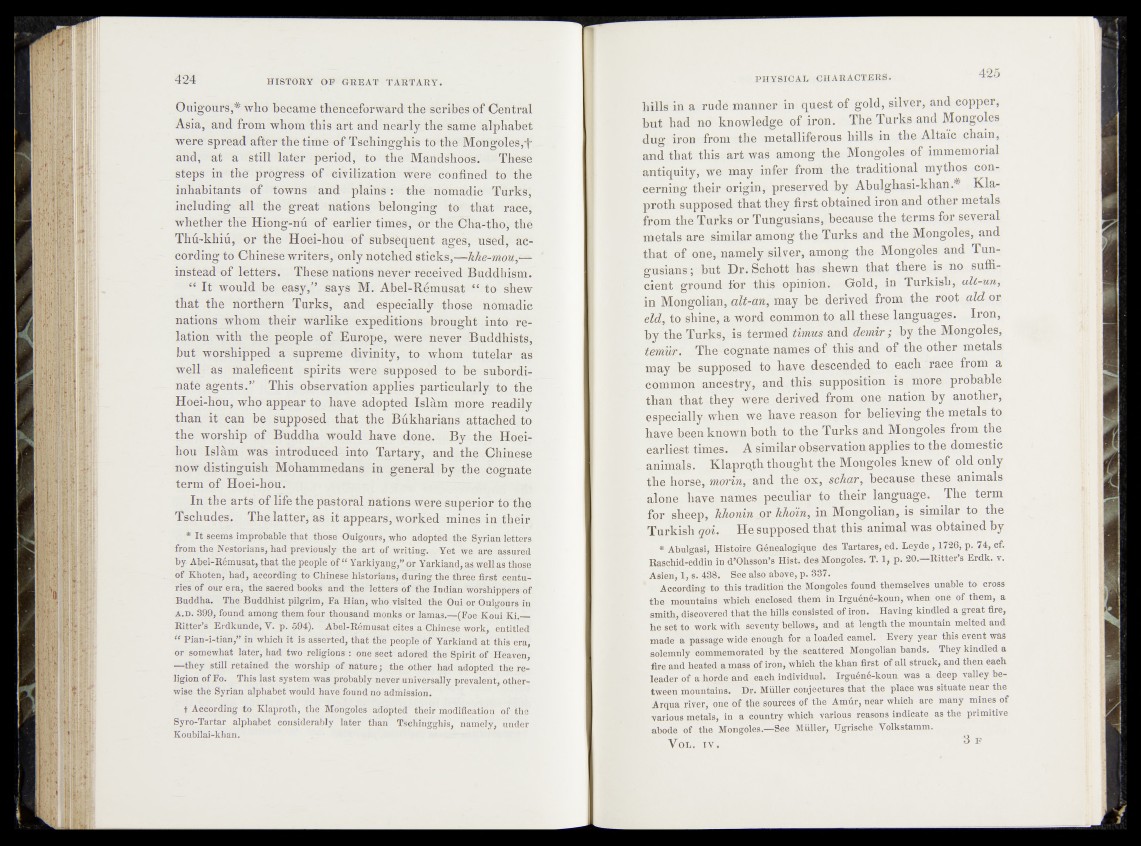
Ouigours,* who became' tbeneeforivard the scribes of Central
Asia, and from whom this art and nearly the feitö alphabet
were spread after the time of Tschingghis to the Mongfölesy'f*
and, at a still later period, to -the Mand&hoOs. These
steps in the* progress of civilization were^confinecb to the
inhabitants of towns and plains : the nomadic Turks*
including all the great nations belonging to that race,
whether the Hiong-nu of earlier times, or the Cha^tho,- the
Thn-khiu, or the Hoei-hou of subsequent ages, used, according
to Chinese writers, only notched sticks,—
instead of letters. These nations never received Buddhism.
“ It would be easy,” says M. Abel-R6musat “ to shew
that the northern Turks, and especially those nomadic
nations whom their warlike expeditions brought into relation
with the people of Europe, were never Buddhists,
but worshipped a supreme divinity,1 tö w;hom tutelar;'as
well as maleficent spirits were supposed ,to be subordi-
natë agents.” This observation applies particularly, fo th;e
Hoei-hou, who appear to have adopted Islàm more readily
than, it can be supposed that the Bukharians attached to
the worship of Buddha would have done. By the Hoe%
hou Islam was introduced into Tartary, and .the Chinese
now distinguish Mohammedans in general by the cognate
term of Hoei-hou.
In the arts of life the pastoral nations were superior to the
Tsehudes. The latter, as it appears, worked mines in their
* It seems improbable that those Ouigours, who adopted the Syrian letters
from the Nestorians, had previously the art of writing, Yet we are assured,
by. Abei-ïtémusat, that the people of “ Yarkiyang/’ or Yarkiand, aswell as those
of Ehoten, had, according to Chinese historians, during the threefirst^ceatu-
ries of our era, the sacred books and the letters óf the Indian worshippers of
Buddha. The Buddhist pilgrim, Fa Hian, who visited the Oui or Ouigonrs in
a.d. 399, found among them four thousand monks or lamas.—(FoeKoui Ki —
Ritter’s Erdkunde, V. p. 594). Abel-Rémusat cites a-Chinese work, entitled
“ Pian-i-tian,” in which it is asserted, that the people of Yarkiand at this era,
or somewhat later, had two religions : one sect adored the Spirit of Heaven,
—they still retained the worship of nature; the other had adopted the religion
of Fo. This last system was probably never universally prevalent, otherwise
the Syrian alphabet would have found no admission.
t According to Klaproth, the Mongoles adopted their modification of the
Syro-Tartar alphabet considerably later than Tschingghis, namely, under
Koubilai-khan.
hiïïs in a rude manner in quest of gold, silver, and copper;
but had no knowledge of iron. The Turks and Mongoles
dug iron from the metalliferous hills ip. the Altaic chain,
and that thw art was among the Mongoles of immemorial
antiquity,1 ■* we mayniufer from the traditional fflythos concerning
their origin,' preserved by Abulghasi^hhan.# Klaproth
supposed that they first obtained iron and other metals
from the Turks or Tungusians, because the terms for several
metals are similar among the Turks, and the Mongoles, and
that of one,, namely silver, among the Mongolei and Tungusians
; hut Dr. Schott has,shewn that there- is no sufficient
ground for this' opinion^ Gold, in Turkish, alt-un,
in Mongolian, alt-an, may, be derived from the root aid or
eld, t o a word common to all t^ese langu^gps. Iron,
hy the Turks,. is termed timus and demir ; by,the Mongoles,
temwr. The-cognate names of this and of the other metals
may he , s.upposed to have descei^decl to 4each ^a^e from a
common aäi(|^try, and,,this .supposition is more - probable
than that they were derived from one ■ nation*, by another,
especially*, when we bave.reason for believing the metals to
have been known both tp fhe Turks and Mongoles fr<^ the
earliest times. A similar observation applies to the domestic
animals! Klaprqth thought the Mongoles knew of old. only
the hbrsei morin, and the ox, schar, because. tjhe^e animals
- alone have names .^peculiar to their language. The term
for sheep, h h o n in or hhoin, ia Mongolian, is similar to the
Turkish qoi. He supposed that this animal was obtained by
* Abulgasi, Histoire Généalogique des Tartaros, ed. Leyde, 1726, p. 74, cf.
Raschid-eddin in d’Ohsson’s Hist. desMongoles. T. 1, p. 20.—Ritter’s Erdk. v.
Asien, 1, s. 438. See also above, p. 337.
' According to this tradition the Mongoles found themselves unable to cross
the mountains which enclosed them in Irguéné-koun, when one p f them, a
smith, discovered that the hills consisted of iron. Having kindled a great fire,
he set to work with seventy bellows, and at length the mountain melted and
made a passage wide enough for a loaded camel. Every year this event was
solemnly commemorated hy the scattered Mongolian hands. They kindled a
fire and heated a mass of iron, which the khan first of all struck, and then each
leader of a horde and each individual. Irguéné-koun was a deep valley between
mountains. Dr. Müller conjectures that the place was situate near the
Arqua river, one 6f the sources of the Amûr, near which are many mines of
various metals, in a country which various reasons indicate as the primitive
abode of the Mongoles.—See Muller, TJgrische Yolkstamm.
VOL. TV. , 3 F